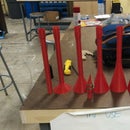Introduction: Laser Cut Box Guitar
I have been working on perfecting a box laser cut ukulele which I recently posted. I decided to scale this up to a guitar size with good results overall. I was going to wait to post this until I perfected it a bit more, but realistically who knows when that will be. The neck for this is a little too thick and heavy, and there are a few other things I will probably change when I go to make a second one. I also hope to include more photos when I do the next one. I thought I was taking a lot of photos along the way when making this, but it turns out I didn't take as many as I thought. This is made using ~10 12" x 18" sheets of baltic birch plywood, a section of hardwood dowel, tuning pegs, and strings.
When I do get a chance to build a second box guitar, I will add more details to this Instructable. If you are stuck with the steps for this, please see the laser cut box ukulele Instructable I have posted since they are very similar.
A student who played this for me after I had finished with rounding off the neck, staining it, etc. thought it sounded good but not as live or full as his guitar. The shape, bracing of the top, and thickness and material for the top are probably the next step. I'm not planning of playing with nicer woods for this at this point since one of my main goals is to keep the cost down. I may try doing the curved sides like the tenor ukulele is did, but I need to finish the forms for this and find some time. It also won't be as good as student project for beginners.
Attachments
Step 1: Bracing-Front Panel and Bridge
Since this is larger than the ukulele I added some bracing on the inside of the top panel of the guitar. I would like to play around with this part of the design to see how it changes the resonance of the guitar body. I cut out two thicknesses of the bracing and glued them together and attached them to the inside of the top panel. Be sure to cut the dowel down, drill holes, and attach it with zip ties before gluing together the body. (See the ukulele Instructable for more details). I used the bridge on my electric guitar to get the spacing for the holes in the bridge.
I drilled holes through to mount the bridge to the guitar. I will add laser cut slots for the zip ties in the next design.
Glue together the body of the guitar without attaching the top panel.
Step 2: Bracing - Neck
The neck pieces are layered like they were for the box ukulele but with much longer "teeth" that stick through the top panel of the body and through two braces that help hold them in place and support the neck from pulling or twisting. Try dry fitting all of these pieces before gluing to get an idea of how they go together. Once you start gluing, you will want to get all of the pieces together fairly quickly.
Once you have the neck glued in place, you can glue the top panel in place.
Step 3: Head Stock and Neck
The head stock is made from 5 pieces. The top piece doesn't have the screw holes in it. When you glue this, it is a good idea to attach the tuning pegs (3 left and 3 right) before the glue dries. You may need to adjust the position and size of the screw holes depending on what tuning pegs you buy. I purchased the cheapest geared tuning pegs I could find on Amazon.
Step 4: Fret Board
The neck has "ramp" pieces attached and the nut attached like discussed in the box ukulele Instructable. There are two layers cut out for the fret board. The top layer has the fret lines etched in using the laser cutter. Sanding the neck flat before attaching the fret board pieces is a good idea. Glue the head stock on the top of the guitar. I would make sure this is clamped well while drying to it doesn't pull off when the strings are added and tuned.
I used ukulele fret wire for this and sanded the edges down once I have the wire glued in place. I also used a palm sander and Dremel rotary sander to round the neck substantially and round off the corners on the body of the guitar.
Step 5: Done
I have also gone through stringing this and staining the body. Overall I am happy with the sound of the guitar. I used fishing line to try it out for stringing the guitar but switched to purchased nylon strings to get a better sound.
I know this Instructable needs more details. Please let me know if you have any questions I can answer before I get around to building a second one and adding the details.
Thanks.














